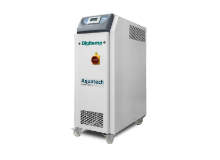
With a range of three models available in the single or dual circuit versions, Piovan Digitemp Thermorefrigerators are a new solution of water-cooled chillers.
Designed especially for injection and blow-moulding machines, these units supply water at a specific temperature, pressure and flow rate, performing the dual function of heating and cooling the process circuit. The working range, from -5°C to a maximum of 90°C per circuit, makes Digitemp models ideal for all those applications that require flexible management of the different temperature requirements of each processing machine.
The main characteristic of Piovan thermorefrigerators is their digital scroll compressor which ensures exceptional performance while maintaining very low energy consumption, in comparison with other units currently on the market. This type of compressor has the advantage of being able to work continuously and reduce the cooling capacity from 10% to 100%.
The result is careful and optimised use of energy, which varies according to the cooling power / thermal yield, but also a more precise temperature control, with no fluctuations, in comparison with compressors of the traditional type.
In addition, the use of the electronic expansion valve, included in the standard configuration, and of only one pump per circuit, further enhances the energy efficiency of the Digitemp units. Thanks to these exclusive construction features of the Piovan range, DT thermorefrigerators ensure an overall energy saving from 30% to 50% compared with equivalent models already on the market.
Lastly, the possibility of integrating the free-cooling system in the unit for supplying water from a dry cooler or a cooling tower, even in the presence of glycol, permits even greater energy efficiency and as well a reduction of the running costs.
Another key feature of the Digitemp range is its compact design. With a floor space of only 0.4m² and a height of 108cm, these models are also the most advantageous as regards dimensions, simplifying installation and saving production space. Another point in favour of these models is the use of the refrigerant gas R410a, anticipating EU regulations and respecting environmental concerns.

